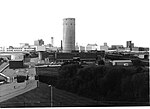Yeading Brook

Yeading Brook is the dominant source of the River Crane, in outer North West then West London. The western branch flows 25.8 km (16.0 mi) south. It rises in the far south of suburban Pinner and drains all of the western suburbs of Harrow, insofar as they have not been by historical practice connected into sewers. Rapidly the brook coalesces at sports grounds associated with and including Headstone Manor, where there is a surviving medieval moat, and leaving the far west of Harrow it makes a large curve to adjoin southern parts of Ruislip then Ickenham Marsh nature reserve, before finishing the more than three-mile sharp curve on the south side of Northolt Aerodrome 1 mile (1.6 km) southwest of South Ruislip railway station. At this point the Yeading Brook's eastern branch feeds in as others have already from South Harrow. The brook bisects Yeading and then forms the traditional border between Hayes and Southall, being superseded by the unlinked Paddington Arm a few metres to the east. The Crane has no authoritative source of its own and so the Yeading Brook – about double the length – forms the upper part of the Crane's river system.
Excerpt from the Wikipedia article Yeading Brook (License: CC BY-SA 3.0, Authors, Images).Yeading Brook
North Hyde Road, London Hayes (London Borough of Hillingdon)
Geographical coordinates (GPS) Address Nearby Places Show on map
Geographical coordinates (GPS)
| Latitude | Longitude |
|---|---|
| N 51.498055555556 ° | E -0.41083333333333 ° |
Address
North Hyde Road
North Hyde Road
UB3 4QS London, Hayes (London Borough of Hillingdon)
England, United Kingdom
Open on Google Maps









